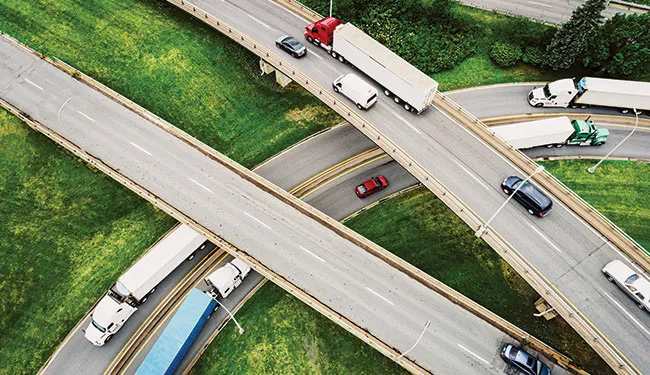Shipper Visibility Requirements Are Changing — Are You Ready?

If you’re a trucking company, 3PL, or broker that moves trucks, this post is for you.
Shippers—whether they’re manufacturers, retailers, food & beverage, industrial sectors (and others) —are rapidly increasing their expectations around carrier communication and visibility. What used to be “nice to have” is now non-negotiable. And it’s only going to get more demanding.
Let’s start by shifting perspective.
Most shippers don’t view transportation as an isolated activity. It’s part of a larger supply chain ecosystem that includes inbound supply, procurement, production, inventory, warehousing, and fulfillment. Decisions ripple across this entire network. What may seem odd or overly demanding to a transportation provider often makes perfect sense when you consider the bigger picture.
The core of this shift is data—specifically, real-time data that feeds into “Control Tower” systems used by shippers to optimize everything from inventory placement to production schedules. Whether it’s concept-to-customer in manufacturing or traceability and compliance in food distribution, shippers rely on transportation data to make critical decisions.
Visibility is now table stakes.
Check calls or email from a dispatcher? That’s outdated. Today, shippers expect structured, timely, automated data and do NOT want to manually process it.
What Shipper SOPs Look Like
At 1LT, in our shipper side of the business, we’ve worked directly with enterprise shippers and 3PLs to build Carrier Compliance Programs. These programs define SOPs (Standard Operating Procedures) that their carriers and 3PLs are expected to follow.
While SOPs vary by shipper, most include core milestones data on:
- Arrived at Pickup
- Departed Pickup
- Arrived at Delivery
- Delivery Complete
- In-Transit Updates (typically every hour with GPS coordinates)
Additional data points often include:
- Pickup/Delivery Appointments
- Updated ETAs
- Shipment Delays
- Tender & Acceptance
- Temperature Monitoring
Timing matters – as real-time as possible but that typically means within 15 minutes of an event.
Why GPS and ELD Data Are Central
Carriers already own ELD devices, and these produce rich GPS and event data. Much more accurate than doing geofencing. The trick is integrating that data into your TMS and feeding it into your customers’ systems automatically. When that happens, you remove the need for your customer to buy third-party visibility platforms—by giving them direct, verifiable updates. You the carrier own the ELD data, why are you making your customer buy 3rd party systems to get your data? That just does not make sense. You the carrier are responsible for visibility not your customer.
Many enterprise shippers already have sophisticated TMS platforms capable of processing this data. They’d prefer to get it from you, the source, rather than pay a third party.
Carrier Compliance Is the New Normal
If this sounds familiar, it’s because this shift already happened in Parcel, and is mostly complete in LTL. Truckload is next. Even 3PL/brokerage moves need to find a way to communicate with the end carrier and create the data for the customer. A shipper does not care if it was a brokered or 3PL move – they need to see the data the same.
Enterprise shippers are already scoring carriers/3PLs based on compliance. If you can’t meet the visibility requirements, you’re at risk of being dropped from routing guides. We’ve seen it firsthand—carriers told to comply or lose freight.
At 1LT, our Carrier Compliance module helps shippers and 3PLs monitor this in real time. Our system uses rule-based logic and AI to track every shipment, alert carriers of missing updates, and—if needed—open a two-way communication path to quickly resolve issues.
Think of it like a living spreadsheet of active loads with embedded links to simple data entry forms for carriers. We convert that into automated status messages that update the shipper’s systems—no manual rework required.
The TL Technology Gap
One of the biggest challenges is legacy tech.
Many TL carriers are running older TMS platforms that just weren’t designed for this level of visibility and workflow automation. And this isn’t just an EDI issue—you can’t solve it by outsourcing the integration. The real problem is upstream: the logic and workflows inside your TMS.
Yet some carriers have solved it. Larger fleets with big IT budgets and newer fleets on modern TMS platforms are already fully compliant.
That leaves a wide swath of midsize carriers and 3PLs stuck in the middle. But here’s the good news: it’s solvable.
How 1LT Can Help
At 1LT, we can’t rebuild your Fleet or 3PL TMS, but we can work with it. As experts in TMSs – we specialize in helping carriers and 3PLs design lightweight, self-managed flexible workflows that let them meet shipper compliance requirements without overhauling their entire system. On the other side of the desk, if you’re a shipper/3PL we help you get your carriers in compliance.
Whether you’re working with an older fleet TMS or just 3PL struggling with client-side communications, we’ll help you turn your data into structured, real-time integrations that your customers actually want.
This is the future of freight visibility and shipper/carrier communications. Shippers are moving fast. Will you be ready—or boxed out?
Let’s talk.
info@1logtech.com
www.1logtech.com